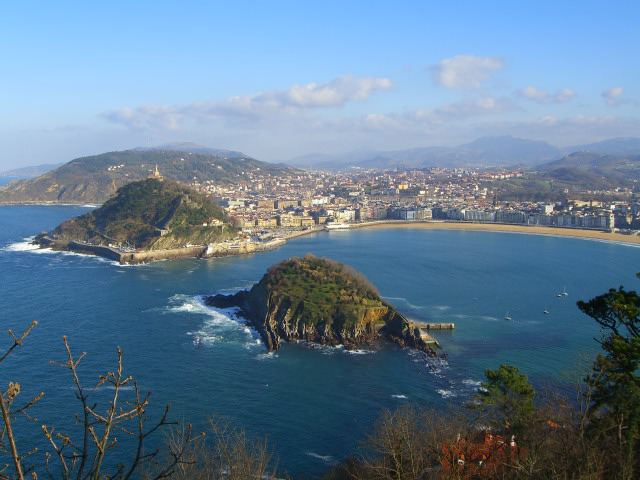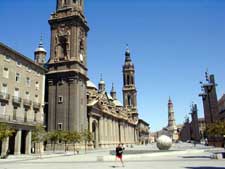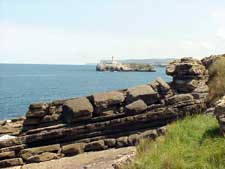Introduction to Spain
The third largest country in Europe, Spain includes two island groups, the Canaries, and the Balearics and reaches down to the tip of North Africa.
Tip: Read this website, if you plan to visit Spain. It is written by an American Family living in Spain and they share some great tips about living and traveling in Spain.
Spain encompasses several very different cultures. The Basques live in the Pyrenees region, and really do not consider themselves Spanish. The Catalans who inhabit Barcelona and environs have their own independent identity as well. The Spaniards who inhabit the rest of Spain are noble people who are proud of their country. The common strain that units these diverse people is their love of family and their love of life.
A visit to Spain, no matter which region you choose, will be a treat for the senses. The flavors, the colors and the lifestyle of Spain are nothing short of flamboyant. So enjoy yourself in this diverse and rich country.
Passports & Visas
Passports are required to enter and leave the European Union (EU). Once you have entered an EU country, you are free to travel within all EU countries without producing a passport. Visas are not required for US citizens for visits of less than 90 days. For longer visits, contact the nearest Spanish embassy.
Obtaining a US passport
The US Government Website is where to start.
Visa information
Contact: Consulate General of Spain
For local Consulates, look under Consulates on the Website
American Offices
Provides consular assistance to U.S. citizens
United States Embassy
Calle de Serrano 75
28006 Madrid
Tel: 91 577 40 00
Spain Tourist Information
Culture and History
Here is a Brief History of Spain
Currency in Spain
Spain’s currency is the Euro €. Traveler’s checks are still accepted throughout the country, but credit cards and Euros are really the most acceptable way to pay for your purchases. ATMs are now very easy to find. The best exchange rates are often found with the use of credit or debit (ATM) cards. Banks tend to have better exchange rates than local “casas de cambio” (exchange bureaus). Spanish banks are generally open weekdays from 8am to 2pm. Some offer Saturday hours, but most do not.
Driving in Spain
Driving in Spain is a little different than driving in England, France or the US; you will need to get used to the fact that Spanish drivers drive fast and don’t always obey the rules. That said, in rural areas of the country, a car is really the best mode of transportation. But, you had better be sure to observe traffic signs, usually marked with easy-to-understand symbols.
Of note, turning left at a busy intersection often involves turning right first, sometimes to use a bridge or underpass, though sometimes it is necessary to turn at the next available junction and reverse direction. At all intersections, drivers must yield to the right unless otherwise indicated.
Speed limits are generally: 120 km/hour (75 mph) on toll roads, 100 km/hour (62 mph) on non-toll roads, 90 km/hour (56 mph) on main roads, and 60 km/hour (37 mph) in developed areas. Speeding fines must be paid on the spot. Also be warned that the blood alcohol limit is 80mg per milliliter and tests are frequently administered by police officers.
Electricity in Spain
The majority of Spain’s electrical outlets supply 220 volts, although a few older establishments may still employ 125-volt outlets. Both versions require the standard European two-prong adapter. Additionally, make sure your appliances can accept 220 volts of power (American outlets provide 120 volts) or you’ll need a converter and an adapter. Some appliances and computers can accommodate either 120 or 220 volts either automatically or with just the flip of a switch on the appliance. (Check it out before you buy)
Emergency Numbers
Dial 112 anywhere in the EU for emergency services.
Etiquette in Spain
The Spanish are very friendly and sociable. They greet strangers warmly, and often start conversations with people they don’t know. Remember that you are a guest in their country, so be polite. When introductions are made or when Spaniards greet each other, they often shake hands. Be polite and greet shopkeepers when entering and exiting their establishments.
Public Hours in Spain
Most shops in Spain are open from 10am to 2pm and from 5pm to 8pm. Bakeries and bars open earlier, often at 8am. Markets are generally open only in the mornings. Department stores may stay open over lunchtime. In some areas, shops are closed on Sundays.
Safety
In general, Spain is a safe place to visit. Violent crime is rare. However, use common sense. Do not walk alone through poorly lit areas. If you are carrying a bag or camera, sling it across your torso instead of carrying it on a shoulder where it can be easily grabbed. Watch out for pickpockets; they sometimes work in teams where one will provide distraction while the other lifts your valuables. Trust your instincts: if something doesn’t seem right, extricate yourself from the situation.
Time Zone
Peninsular territory (Spain and Portugal) and Balearic Islands go by the Greenwich Meridian time zone (GTM) plus 1 hour in the winter, and 2 hours in the summer.
In the Canary Islands the time zone is that of the Greenwich Meridian, plus 1 hour in the summer ( always one hour behind peninsular Spain )
Tipping in Spain
Tipping is not expected in Spain, except in those most American of tourist spots. Tipping is not part of the Spanish culture. But, it is never wrong to leave a little tip if you really appreciate the service. You can round off the bill or just leave a few coins as a sign of thanks.
Toilets or Los Servicios
Most restaurants, bars, and department stores offer facilities for customers. Additionally, toilets can be found at service stations. Some locations may require you to ask for a key (la llave).
Weather in Spain
Spain has a warm, Mediterranean climate, with dry summers and mild winters It boasts more than 3,000 hours of sunshine per year. Because of Spain’s immense geographical diversity the weather varies depending on where you are. In the north at the Cantabrian coast, you will find a mild climate with high rainfall. Winters are mild and in summer temperatures rarely exceed 25ºC.
In the higher elevations of the country, such as Pyrenees, the Sierra Nevada mountains, the Central and Iberian ranges, and the Cantabrian Mountains, it is common to see snow from the beginning of winter to the end of spring. The Canary Islands have a mild climate with only small temperature differences between day and night, whatever the season.
Getting Around in Spain
Air Transportation
A comprehensive guide to
Boats and Ferries
Ferry services are available to shuttle travelers to Spain’s Balearic and Canary Islands. Additionally, ferries travel regularly between Spain and the UK, as well as between Spain and North Africa. We recommend making advance reservations, particularly during the busy summer months.
Ferries linking the UK with Spain include: Brittany Ferries (travel route between Plymouth and Santander) and P&O European Ferries (travel route between Portsmouth and Santurce). Crossings take more than 24 hours.
Trasmediterranea Ferries travel to the Balearics and Canaries. The trip to the Balearics takes approximately eight hours. The trip to the Canaries runs around 39 hours. Trasmediterranea also operates the ferries that travel between Spain and North Africa.
Rail
Spain’s railroad, the Red Nacional de Ferrocarriles Espanoles (RENFE), offers service throughout the country. High-speed trains – called the TALGO and the AVE – run along major routes. The “largo recorrido” (long-distance) and “regionales y cercanias (regional and local) trains cover the less-traveled routes. Be forewarned, while these trains are cheaper, they are also quite slow, making numerous local stops along the way.
Feve (spanish only) and other carriers operate in individual autonomous communities. Most of the larger cities have a metro or light rail system.
Car Rental in Spain
It is usually less expensive to arrange your car rental while you are still in the USA or home country. Almost every rental agency that you might be familiar with has a Europe outlet. To drive in Spain you must be at least 18 years old. To rent a vehicle, you must be at least 21. If you are from a country that is not in the EU, you will need an International Driver’s License. To get an International Drivers license, contact your local AAA.
Taxis
In the larger cities, taxis can be found at airports, railroad and bus stations, and usually in the main hotel or shopping areas. A green light indicates that a taxi is available. Most have meters that will display a base rate and climb from there.
In smaller towns, taxis may not be metered and may even be private cars. It is advisable to ask a hotel or shop clerk for a name and number of a local driver. Also, negotiate a price before the trip begins.
Health
Pharmacists can advise and often prescribe medications without a doctor’s consultation. For non-emergencies, look for the “farmacia” sign, a green or red illuminated cross, and seek out a “farmaceutico” or pharmacist. Many speak English. Pharmacies with night hours are listed on all local pharmacy windows.
Personal Medications
No permit is required to carry medication in your luggage. However, you should pack your medication in its original containers and/or have your doctor’s prescription with you. Customs officials will have to be satisfied that you are not importing more than would be necessary for your personal use, taking into account the drug type and length of stay (for no more than three months).
Lodging in Spain
Spain offers every type of lodging from couchsurfing, to hostels and agritourism , to 5-Star resorts.
Main Sights in Spain
Here’s our list of the main Sights in Spain.
Public Holidays in Spain
January 1 – New Year’s Day (Ano Nuevo)
January 6 – Epiphany (Dia de los Reyes)
March/April – Maundy Thursday (Jueves Santo), Good Friday (Viernes Santo), Easter Sunday (Dia de Pascua)
May 1 – Labor Day (Dia del Trabajo)
August 15 – Assumption Day (Asuncion)
October 12 – National Day (Dia de la Hispanidad)
November 1 – All Saints’ Day (Todos los Santos)
December 6 – Constitution Day (Dia de la Constitucion)
December 8 – Immaculate Conception (Inmaculada Concepcion)
December 25 – Christmas Day (Navidad)
Telephones in Spain
Public telephones are usually easy to find. In addition to public phone booths (cabinas) on the street, most bars have pay phones as well. Most can be operated with either coins or cards. Phonecards can be purchased at most newsstands. There are also public phone offices (locutorios) where calls can be made and paid for afterward. Telefonica, the Spanish telecommunications company, operates the cheapest phone offices; private locutorios, often found in shops, are more expensive.
Dialing Procedures
To reach an Operator, dial 1003.
For calls from the USA or abroad to Spain, dial the country code (34), followed by the area code (this will be a number beginning with 9), followed by the local phone number. While phoning within Spain, dial the area code (this will be a number beginning with 9) and then the local phone number.
Useful Country Codes:
Spain – 34
USA and Canada – 1
UK – 44
Returning to the US
Customs,VAT & Duty Free
When you return to the U.S., you’ll need to declare everything you bringing back that you did not take with you. If you are traveling by air or sea, you may be asked to fill out a Customs Declaration Form provided by the airline or cruise ship. Keep your sales slips. Try to pack the things you’ll need to declare separately. Read the signs in the Customs area; they contain helpful information about how to clear Customs.
For complete information on Customs, look at the U.S. Government Customs Website
Value Added Tax (VAT or IVA) Refund Information – We have found it such a hassle to try to reclaim the VAT tax that we simply do not bother. If however, you will be spending a great deal of money, it might be worth the many steps you will need to go through. Also, remember that a 7 percent V.A.T. (Value Added Tax) tax is added to rates for all restaurants and hotel rooms. Service is included. This 7% V.A.T. tax on services is not refundable.
Travelers to Spain from outside the EU are entitled to a reimbursement of the 16 % V.A.T. (Value Added Tax, IVA in Spain) they pay on all purchases as long as the purchases add up to no less than 90 Euros in the same store and on the same day. The vendor must provide the purchaser with a duly filled out invoice which shows the price of each good included in the paid V.A.T. , as well as the identification (name and address) for both vendor and purchaser. The goods must be brought out of the European Union within three months from the date of purchase.
At the time of departure from Spain and final departure from the European Union territory, and before checking in your baggage, you must bring your invoice(s) and the merchandise purchased to the Spanish Customs in order for them to process your V.A.T. refund claim (there is a specific booth for this purpose just prior to the entrance to the international area at the international port, gate or airport).
Duty Free
If you are a U.S. or Canadian resident, you may qualify for a personal exemption which allows you to bring goods of a certain value into the country without paying customs duties, excise taxes, or Value Added Tax.





Nancy Todd
Wednesday 15th of June 2011
You mention the use of travelers checks. It is now almost impossible to cash a traveler's check now in Spain. A friend went to 8 banks before she could cash one. And that was three years ago. The good old credit card works!
villa calpe
Tuesday 26th of October 2010
Awesome post......... This post helps all travelers who want to travel Spain for there vacation.This post is so terrific and fantastic ,provides the whole details and there concerns regarding to travel to Spain.The Spain tourist information is really a reliable and flexible.I am very grateful to Terry for this post.This all information helps me during my travel To Spain.
Jules
Sunday 23rd of May 2010
The Canary Islands are part of Spain but located off the coast of Africa and the last stop before sailing across the Atlantic. There are seven islands with Tenerife, Gran Canaria, Lanzarote and Fuerteventura the most well known for tourism.
The islands have a fantastic winter climate with an average of 22 degrees and 6 hours daily sunshine , our rainfall is an annual 125mm !!
Each island is different and you can island hop by ferry or plane.
It is a 2 hour flight from Madrid or 4 hours from UK, there are lots of connections to Europe.
The main languages spoken are Spanish, English and German.
There's lots to discover and explore, try the Canary Islands (Islas Canarias) as an alternative to mainland Spain.